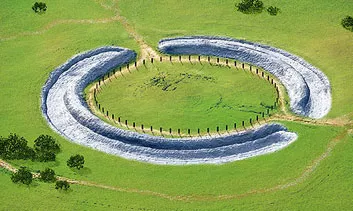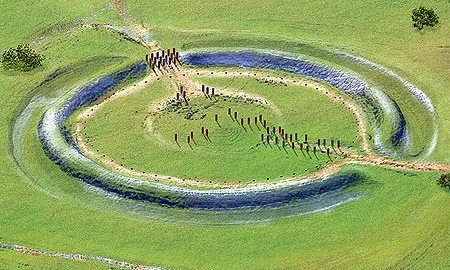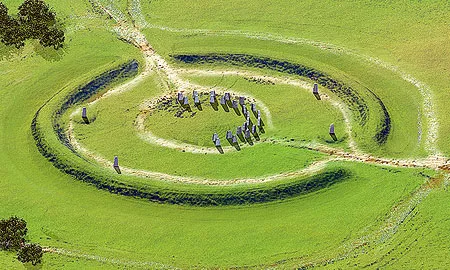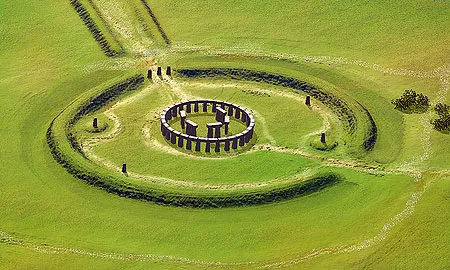Mystery Man of Stonehenge
The discovery of a 4,300-year-old skeleton surrounded by intriguing artifacts has archaeologists abuzz
In the spring of 2002, archaeologists were nearly finished excavating the site of a planned housing development in Amesbury, a town in southwestern England. It had been a “routine excavation—bread and butter, as it were,” says archaeologist Andrew Fitzpatrick, leader of the team from Wessex Archaeology conducting the dig. The team had uncovered a small Roman cemetery, a fairly common finding. Now all that was left to check out were two rough patches of ground—“blobs,” Fitzpatrick calls them—in a far corner of the site.
Early on that Friday in May, the crew went to work on the blobs with their trowels. By midmorning, they had determined that the blobs were graves. By lunchtime, they’d realized the graves predated the Roman cemetery by more than 2,500 years; in one, they uncovered the first of five clay funerary pots, having a “beaker” style associated with Britain’s Bronze Age (2300-700 B.C.). Then a worker found “something shiny,” as the crew leader reported that afternoon in a phone call to Fitzpatrick, who hurried to the site. The shiny “something” was a piece of gold.
Fitzpatrick ordered the workers to collect all the earth from the graves so that his staff back in the lab could sift through it and recover any fragments of relics or remains. With no way to hire guards for the site on the eve of a three day holiday weekend, the team had to complete the job right away. After the sun went down, they illuminated the area with car headlights, finishing at 1:42 a.m. that Saturday. Later, when the sifting was done, 100 artifacts had been retrieved—the richest Bronze Age grave ever discovered in Britain.
There were two male skeletons, the most important of which was interred in a timber-lined grave on its left side, facing north. The legs were curled in a fetal position, common in Bronze Age burials. An eroded hole in the jawbone indicated that he’d had an abscess; a missing left kneecap was evidence that he’d sustained some horrific injury that’d left him with a heavy limp and an excruciating bone infection. A man between 35 and 45 years of age, he was buried with a black stone wrist guard on his forearm of the kind used to protect archers from the snap of a bowstring. Scattered across his lower body were 16 barbed flint arrowheads (the shafts to which they presumably had been attached had long since rotted away) and almost 100 other artifacts. The archaeologists started calling him the Amesbury Archer, and they assumed he had something to do with Stonehenge because the massive stone monument was just a few miles away. Because of his apparent wealth, the press soon dubbed him the “King of Stonehenge.”
Begun about 3000 B.C., Stonehenge was built in stages over 1,400 years. The structure, whose purpose remains a mystery, started out as a huge earthen ditch with wooden posts and walls. The familiar 4-, 20- and 30-ton standing stones were erected between 2400 and 2200 B.C.—about the time the archer was buried nearby. Because radiocarbon dating has about a 200-year margin of error, however, not everyone is ready to call the archer a king. Mike Parker Pearson, archaeology professor at the University of Sheffield in England, points out that the archer may have come on the scene several decades after the stones were erected.
Compared with the glittering tomb of the Egyptian pharaoh Tutankhamun, who reigned some 1,000 years after the mysterious Stonehenge figure, the archer’s possessions may not seem like much: in addition to the arrowheads and wrist guards, the grave held five pots, three tiny copper knives (one barely an inch long), a cache of flint- and metalworking tools, including a cushion stone—a hand-size piece of rock shaped like a sofa cushion that served as an anvil—and a clutch of boars’ tusks. The grave also held a pair of gold hair ornaments—the earliest gold objects found in Britain. Other graves in the area, on the other hand, typically contain little more than a clay pot; by comparison, the archer died a very rich man indeed. “Most people would not have had the ability to take such wealth with them into their graves,” says Mike Pitts, author of Hengeworld, who calls the find “dynamite.”
The concepts of individual wealth and status were just taking root in Europe during the Bronze Age, when most trade was still conducted by barter. The preceding Stone Age is marked by what appears to have been relative economic equality, with no grave appreciably richer than any other. Archaeologists long thought this egalitarianism extended into the Bronze Age. The Amesbury Archer has overturned that idea.
The archer’s mourners had undoubtedly wished him well, says Fitzpatrick. But what did his grave goods signify? Did his stone wrist guard mean that he was an archer in life, or was it conferred on him posthumously to honor his high status? Were the bow and arrows intended to help him hunt, or to protect him in the next world? Nobody knows. “How the archer acquired his wealth and what it signified are questions that are impossible to answer,” Pitts says.
But forensic archaeology has revealed some telling details. One of the most sensational came straight from the archer’s mouth. To scientists, a person’s tooth enamel is like a GPS for pinpointing his childhood home. The main ingredient of tooth enamel, apatite, is composed of calcium, phosphorous, oxygen and other elements. The composition of the oxygen molecules in apatite depends on the water a person drank as a child, and that, in turn, can reveal a great deal about where he grew up—from the temperature of rain or snow to the distance from a coast and the area’s altitude. Using a laser scan to determine the makeup of the oxygen in the archer’s tooth enamel, a team at the British Geological Survey led by geoscientist Carolyn Chenery concluded that he grew up in a cool region of Central Europe, most likely somewhere close to the Alps or present-day southern Germany.
The notion that he hailed from the Continent has farreaching implications. For decades, scientists believed that beaker pottery, like the pots found in the archer’s grave, was brought by invaders across continental Europe to the British Isles. But most archaeologists now say the pottery—and the knowledge needed to create it—diffused peacefully, through trade or through travelers who were skilled craftsmen.
A more significant imported skill was metalworking. Around 2300 B.C., the stone tools and weapons that had defined Britain’s Stone Age were being replaced with metal implements. The Bronze Age varies from culture to culture, but it is thought to have started in southeastern Europe about 4000 B.C. and then spread westward across the Continent before reaching Britain 4,000 years ago. The archer would have been at the vanguard of the flashy new trade, which sometimes produced items just for show: Fitzpatrick says the archer’s copper knives, for instance, which are too soft to have been used primarily as weapons, were probably for display or eating. (It would take at least another century after the archer’s arrival before the technology of alloying copper and tin to make sturdier implements reached Britain.)
The evidence that the archer not only carried metal but knew how to work it comes mainly from the cushion stones found in his grave. Researchers say it is unlikely that such a tool would have been buried with anyone but its owner. (Carbon dating, and the absence of metal objects from earlier graves, suggest the archer’s arrival roughly coincides with the arrival of metalworking to the British Isles.)
The archer’s skill would have allowed him to move freely from community to community. “The knowledge in his hands and in his head,” Fitzpatrick says, “was the key to his status. He brought a unique or exceptionally rare skill. You can think of the archer as a kind of magician. You can revere metalworkers, but you can also fear them.”
Arriving 4,300 years ago in an area we now call Wiltshire, the archer would have likely encountered a rural setting of round timber houses with conical thatched roofs. (Today, Amesbury center is graced by red brick and pastel-colored stucco buildings, and enterprises beyond the archer’s wildest fantasies: Amesbury Tandoori, for example, and Hair by Joanna.) Of course, the lure of Wiltshire then, as now, was Stonehenge. Speculation about its purpose has centered on the notion that the monument was built in part to capture the rays of the rising sun during the summer solstice, the longest day of the year. A new idea is that Stonehenge was about the winter solstice, or the shortest day of the year. “Stonehenge has been looked at the wrong way around,” says Parker Pearson, one of the winter theory’s proponents. In the past year, archaeologists have reanalyzed material excavated in the 1960s from a nearby monument built about the same time as Stonehenge. Pig remains from wooden structures found within this henge, called Durrington Walls, show that feasting rituals went on in the winter.
“What is happening around that time is a tremendous religious revival,” says Parker Pearson. “We’re dealing with more sophisticated societies than we give them credit for. Stonehenge was built for the ancestors whose funerary rites were held at Durrington Walls and along the river to Stonehenge, with the festival of the dead celebrated at midwinter.”
It is unlikely the archer set off from the Alps expressly to see Wiltshire’s massive structures, though Fitzpatrick says there may have been whisperings on the Continent about their existence. But about the same time he arrived, “something utterly unprecedented, unique in scale and vision took place,” says Pitts: the erection of the 20- and 30-ton stones. Most archaeologists believe the massive stones were hauled to the monument’s location on the Salisbury Plain from the Marlborough Downs, 20 miles to the north—a colossal distance for a society without wheels.
And it’s even possible the archer may have provided the catalyst to get the project started. “He could have brought with him the stock of imagination to conceive of something quite extraordinary,” Pitts says. Perhaps he exploited his position as a charismatic outsider, unsullied by local politics or infighting, to forge alliances among the region’s chieftains. “Building Stonehenge might seem an absolutely crazy thing to do,” says Fitzpatrick. Yet “involving lots of people in a construction project is a way of bringing people together—creating and seizing status.”



